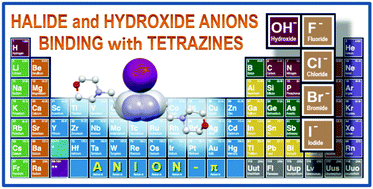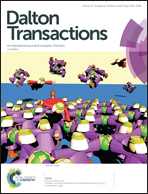Halide and hydroxide anion binding in water†
Abstract
The formation of halide and hydroxide anion complexes with two ligands L1 (3,6-bis(morpholin-4-ylmethyl)-1,2,4,5-tetrazine) and L2 (3,6-bis(morpholin-4-ylethyl)-1,2,4,5-tetrazine) was studied in aqueous solution, by means of potentiometric and ITC procedures. In the solid state, HF2−, Cl− and Br− complexes of H2L22+ were analysed by single crystal XRD measurements. Further information on the latter was obtained with the use of density functional theory (DFT) calculations in combination with the polarizable continuum model (PCM). The presence of two halide or bifluoride HF2− (F–H–F−) anions forming anion–π interactions, respectively above and below the ligand tetrazine ring, is the leitmotiv of the [(H2L2)X2] (X = HF2, Cl, Br, I) complexes in the solid state, while hydrogen bonding between the anions and protonated morpholine ligand groups contributes to strengthen the anion–ligand interaction, in particular in the case of Cl− and Br−. In contrast to the solid state, only the anion : ligand complexes of 1 : 1 stoichiometry were found in solution. The stability of these complexes displays the peculiar trend I− > F− > Br− > Cl− which was rationalized in terms of electrostatic, hydrogen bond, anion–π interactions and solvent effects. DFT calculations performed on [(H2L2)X]+ (X = F, Cl, Br, I) in PCM water suggested that the ligand assumes a U-shaped conformation to form one anion–π and two salt bridge interactions with the included anions and furnished structural information to interpret the solvation effects affecting complex formation. The formation of hydroxide anion complexes with neutral (not protonated) L1 and L2 molecules represents an unprecedented case in water. The stability of the [L(OH)]− (L = L1, L2) complexes is comparable to or higher than the stability of halide complexes with protonated ligand molecules, their formation being promoted by largely favourable enthalpic contributions that prevail over unfavourable entropic changes.



 Please wait while we load your content...
Please wait while we load your content...